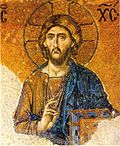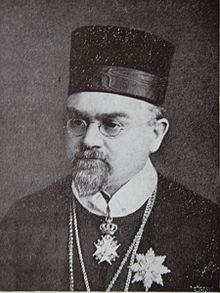- Gorazd (Pavlík)
-
Part of a series on Eastern Christianity 
History Orthodox Church History
Specific regions:
Byzantine Empire
Ecumenical council
Christianization of Bulgaria
Christianization of Kievan Rus'
East-West Schism
Asian Christianity
Coptic Egypt · UkraineTraditions Orthodox Church
Others:
Oriental Orthodoxy
Ethiopian Tewahedo Church
Coptic Church
Church of the East
Eastern Catholic Churches
Syriac ChristianityLiturgy and worship Sign of the cross
Divine Liturgy
Iconography
Asceticism
OmophorionTheology Hesychasm · Icon
Apophaticism
Filioque clause
Miaphysitism
Monophysitism
Diophysitism
Nestorianism
Theosis · Theoria
Phronema · Philokalia
Praxis · Theotokos
Hypostasis · Ousia
Essence vs. Energies
MetousiosisBishop Gorazd of Prague, given name Matěj Pavlík (May 26, 1879 - September 4, 1942), was the hierarch of the revived Orthodox Church in Moravia, the Church of Czechoslovakia, after World War I. During World War II, having provided refuge for the assassins of SS-Obergruppenfuhrer Reinhard Heydrich, called The Butcher of Prague, in the cathedral of Saints Cyril and Methodius in Prague, Gorazd took full responsibility for protecting the patriots after the Nazi overlords found them in the crypt of the cathedral. This act guaranteed his execution, thus his martyrdom, during the reprisals that followed. His feast day is celebrated on August 22 (OC) or September 4 (NC).
Contents
Life
Matěj Pavlík was born on May 26, 1879, in the Moravian village of Hrubá Vrbka in what would later be the Czech Republic. Born into the Roman Catholic society of the Austro-Hungarian Empire, Matthias entered the Faculty of Theology in Olomouc after finishing his earlier education. He was subsequently ordained a priest. During his studies, he was interested in the mission of Saints Cyril and Methodius and of Eastern Orthodoxy.
Establishment of Czechoslovakia in the aftermath of the first world war brought complete religious freedom. In this environment, many people left the Catholic Church. While many left the religion completely, some looked either to old Czech Protestant churches or, as Pavlík, to Eastern Orthodoxy. The Serbian Orthodox Church provided a shelter for those looking to Orthodoxy. As a leader in Moravia, the Church of Serbia agreed to consecrate Fr. Pavlík to the episcopate for his homeland. On September 24, 1921, he was consecrated bishop with the name of Gorazd.
Historically, his monastic name of Gorazd was significant as it was the name of the bishop who succeeded St. Methodius as Bishop of Moravia after he died in 885. Subsequently, Pope Stephen V drove the disciples of St. Methodius from Moravia as the Latin rite was imposed. Thus, by the choice of his monastic name of Gorazd, the continuity of the Orthodox Church in Moravia from some eleven hundred years before was recognized.
Archimandrite Gorazd was named Bishop of Moravia and Silesia on September 24, 1921, and consecrated bishop on the next day at the Cathedral of the Holy Archangel Michael in Belgrade, Yugoslavia, by Patriarch Dimitrije.
Over the next decade or so, Bp. Gorazd and his faithful followers organized parishes and built churches in Bohemia. In all they built eleven churches and two chapels. He had the essential service books translated and published in the Czech language, which was the language used in the church services. With Subcarpatho-Russia and Slovakia part of Czechoslovakia, he assisted many who had returned to their ancestral Orthodox faith.
With the conquest of Czechoslovakia by the Nazis in 1938, the church was placed under the Metropolitan in Berlin, Germany. Reinhard Heydrich was appointed as ruler of Czechoslovakia. On May 27, 1942, a group of Czech resistance fighters attacked and killed Heydrich. In making their escape, the group found refuge in the crypt of the Cathedral. When Bp. Gorazd found out a few days later, he recognized the serious burden this placed on the Czech Orthodox Church. Before he left for the consecration to the episcopate of Fr. John (Gardner) in Berlin, he asked that the resistance fighters move elsewhere as soon as possible. However, on June 18, the Nazis found out the hiding places after a betrayal by two members of the resistance group, and all the members of the group were killed.
Reprisals came quickly. The two priests and the senior lay church officials were arrested. Bp. Gorazd, wishing to help his fellow believers and the Czech Church itself, took the blame for the actions in the Cathedral on himself, even writing letters to the Nazi authorities. On June 27, 1942, he was arrested and tortured. On September 4, 1942, Bp. Gorazd, the Cathedral priests and the lay officials were executed by firing squad at Kobylisy Shooting Range. The reprisals went much further as the Nazis conducted widespread roundups of Czechs, including the whole village of Lidice, then summarily killed the men and children, while they placed the women in concentration camps. The Orthodox churches in Moravia and Bohemia were closed and the Church forbidden to operate. Metropolitan Seraphim courageously refused to issue any statement condemning Bishop Gorazd. It wasn't until the end of the war that the Orthodox Church in Czechoslovakia would function again.
Glorification
By these actions by the Orthodox Faithful, who, led by their bishop, proved the qualities of their little church in bravery and devotion to matters of justice and showed how firmly it was connected to the Czech nation. On May 4, 1961, the Serbian Orthodox Church recognized Bp. Gorazd as a new martyr, and on August 24, 1987, he was glorified in the Cathedral of St. Gorazd in Olomouc in Moravia.
External links
- Listing at the Orthodox Research Institute
- Martyr Gorazd of Prague, Bohemia and Moravo-Cilezsk (OCA)
- "A Twentieth Century Western Orthodox Missionary" by Monk Gorazd
Sources
Categories:- 1879 births
- 1942 deaths
- 20th-century Christian saints
- 20th-century Eastern Orthodox bishops
- 20th-century Eastern Orthodox martyrs
- Czech and Slovak Orthodox Christians
- Eastern Orthodox Christians from the Czech Republic
- Eastern Orthodox Christians opposed to the Third Reich
- Eastern Orthodox saints
- People killed by Nazi Germany
- Recipients of the Order of Tomáš Garrigue Masaryk
- Murdered priests
Wikimedia Foundation. 2010.

